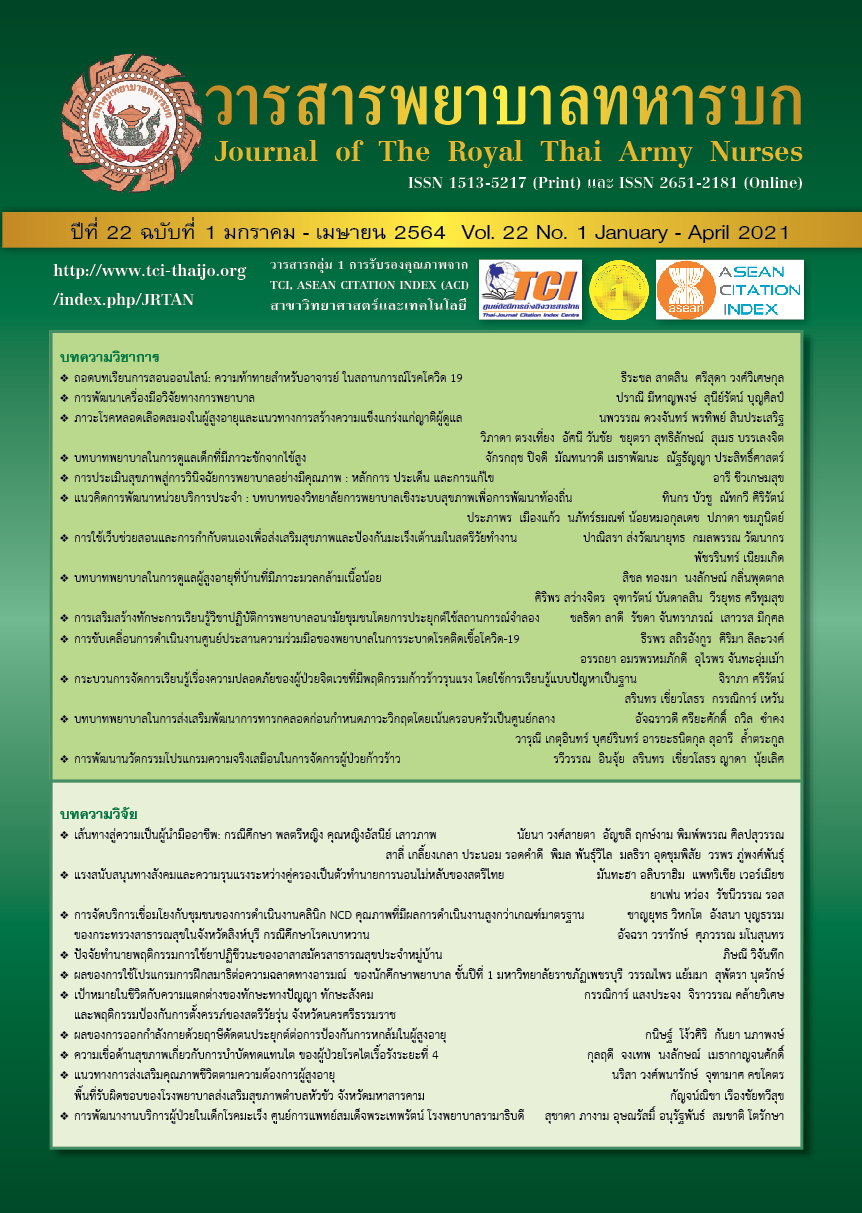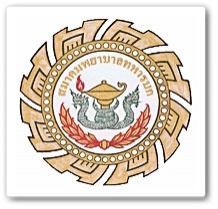The Improvement of Patient Lateral Transfer Equipment to Reduce the Risk of Back Pain of Hospital Personnel: A Pilot Study
Keywords:
Patient lateral transfer, Back pain, hospital personnelAbstract
The purpose of this quasi-pilot study was to assess the risk of back pain of laterally transferring a patient between bed and stretcher (lateral transfer) in hospital personnel. And improve the patient’s transport equipment to reduce the risk of back pain. The sample was 4 hospital porters that performing this task in the hospital. The record form of lifting index and EMG were used to collect data. Descriptive statistics analysis were used to analyze the data.
The study found that the improvement of the device by using bed sheet in the horizontal direction by applying the lifting suggestion decreased the workload of back muscles of the sample standing at the bedside. When evaluated with the lifting equation, it was found that the horizontal distance decreased. As a result, the lifting index decreased from 2.13 to 1.94. EMG of back muscles revealed that the back muscles function decreased in the samples who stood at the bedside. But in the sample at the stretcher-side, it was found that the lifting index did not change. The EMG of the back muscles did not change significantly. The conclusion is an application of lifting suggestions can reduce the risk of low back pain in nursing personnel that performs patient transferring tasks from stretcher to bed while standing at the bedside, but not reduce the risk in the samples at the stretcher-side.
Downloads
References
Workmen Compensation Funds. Occupational injury and illness report 2013-2017. Bangkok: Social Security Office; 2018. (In Thai).
Keawnual A, Lohapoontagoon B, Pochana K. Prevalence of Work-related Musculoskeletal Disorders in various occupations. The Public health journal of Burapha University. 2017;12 (2):53-64. (In Thai).
Chaiklieng S, Somtu J. Risk Factors Related to Low Back Pain among Maternal Child Health Nurses. Journal of medical technology and physical therapy. 2017;20 (3). (In Thai).
Karimian R. Ergonomic Evaluation of the Risk of Suffering from Musculoskeletal Disorders in Nurses with Quick Exposure Check (QEC) and the Effect of 8-week selected Corrective Exercises and Ergonomic Occupational Intervention on their Exposure Rate. Journal of Fasa University of Medical Sciences. 2015;5:210.
Waters TR, Andrea B, Manon S. AORN Ergonomic Tool 1: Lateral Transfer of a Patient from a Stretcher to an OR Bed. The Official Voice of Perioperative Nursing. 2011;93 (3):334-9.
Vinstrup J, Madeleine P, Jakobsen MD, Jay K, Andersen LL. Patient Transfers and Risk of Back Injury: Protocol for a Prospective Cohort Study With Technical Measurements of Exposure. JMIR Research Protocols. 2017;6(11).
Matsumoto H, Ueki M, Uehara K, Noma H, Nozawa N, Osaki M, et al. Comparison of Healthcare Workers Transferring Patients Using Either Conventional Or Robotic Wheelchairs: Kinematic, Electromyographic and Electrocardiographic Analyses. Journal of Healthcare Engineering, 2016;662-673.
Kunkachoo P, Piriyaprasan P, Kruakhon S, Sathanon P, Praditpoj N, Namdang P. Musculoskeletal Injury and Management of the Elderly, Handicapped and Vulnerable Individuals. 2014. (In Thai).
Meepradit P, Panyadee K, Yingratanasuk T. The Effectiveness of the Lateral Patient Transfer Device to Reduce Musculoskeletal Risk among Practical Nurses in a Hospital, Thailand. Journal of Biosciences and Medicines. 2018;6(5):45-51.
Size Thailand Project. Summary of the sizing survey in Thailand 2008. Bangkok; National Science and Technolgoy Development Agency; 2008. (In Thai).
Thailand Nursing and Midwifery Council. Nurses’ working hours policy for patient safety. Thailand Nursing and Midwifery Council; 2017. (In Thai).
Ranavolo A, Varrecchia T, Iavicoli S, Marchesi A, Rinaldi M, Serrao M, et al. Surface electromyography for risk assessment in work activities designed using the “revised NIOSH lifting equation”. International Journal of Industrial Ergonomics. 2018;68: 34-45.
Meepradit P. Ergonomic risk assessment. Bangkok: O S Printing House; 2016. (In Thai)
The Accident Compensation Corporation. Equipment for moving and handling people. New Zealand: The Accident Compensation Corporation; 2012. 191-223
Bartuzi P, Roman-Liu, D. Assessment of muscle load and fatigue with the usage of frequency and time-frequency analysis of the EMG signal. Acta of Bioengineering and Biomechanics. 2014;16 (2):31-9.
Thailand cyber university project. Learning document of health sciences: Office of the Higher Education Commission; 2015. (In Thai)
Jin S. Biomechanical characteristics in the recovery phase after low back fatigue in passive and active tissues. International Journal of Industrial Ergonomics. 2018;64:163-9.
Wang L, Wang Y, Ma A, Ma G, Ye Y, Li R, et al. A Comparative Study of EMG Indices in Muscle Fatigue Evaluation Based on Grey Relational Analysis during All-Out Cycling Exercise. BioMed Research International. 2018.
Park S. Ergonomic Verification of Suitability of the 4-Wheeled Hand Cart to Transfer a Projectile for Towed Howitzer. Journal of Korean Institute of Industrial Engineers. 2016;
Matsumoto H, Ueki M, Uehara K, Noma H, Nozawa N, Osaki M, et al. Comparison of Healthcare Workers Transferring Patients Using Either Conventional Or Robotic Wheelchairs: Kinematic, Electromyographic, and Electrocardiographic Analyses. Journal of Healthcare Engineering 2016;2016:7.
Fragala G., Fragala M.. Improving the Safety of Patient Turning and Repositioning Tasks for Caregivers. Workplace Health & Safety. 2014;62 (7):268-273.
Nagavarapu S, Lavender S, Marras W. Spine Loading during the application and removal of lifting slings: The effects of patient weight, bed height and work method. Ergonomics. 2016;60:1-39.
Coenen P, Gouttebarge V, Dieen J, Frings-Dresen M, Beek A, Burdorf A. The effect of lifting during work on low back pain: A health impact assessment based on a meta-analysis. Occupational and Environmental Medicine. 2014;71(10).
Downloads
Published
How to Cite
Issue
Section
License
บทความหรือข้อคิดเห็นใดใดที่ปรากฏในวารสารพยาบาลทหารบกเป็นวรรณกรรมของผู้เขียน ซึ่งบรรณาธิการหรือสมาคมพยาบาลทหารบก ไม่จำเป็นต้องเห็นด้วย
บทความที่ได้รับการตีพิมพ์เป็นลิขสิทธิ์ของวารสารพยาบาลทหารบก
The ideas and opinions expressed in the Journal of The Royal Thai Army Nurses are those of the authors and not necessarily those
of the editor or Royal Thai Army Nurses Association.






